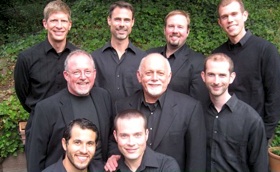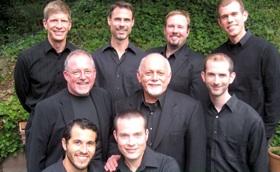OK, I’ll admit it: I am addicted to the cable reality show Project Runway, a competition for fashion designers. The charm of the show lies in observing the designers’ genuine creativity. They are encouraged to be unique and innovative and to express their point of view as a designer while satisfying their clients and facing difficult design challenges.

The pitfalls are numerous. Outfits drawing from an inspiration too literally become “costumey.” Other looks are frowned on, for lack of innovation. Often, a garment is well-conceived but poorly executed — or the opposite. Sometimes a garment does not fit a model. Perhaps the worst criticism comes when a designer’s work is “just clothes,” the type you could buy in any department store.
Like clothing design, choral music is an admixture of craft and art, and, like fashion, there are low and high ends, fleeting trends, boutique and industrial producers, famous labels, and specialized products for different body types. The exemplary San Francisco male octet Clerestory offered a well-styled, upscale, tasteful program Saturday at St. Gregory of Nyssa Church, frequently drawing inspiration from several Middle Eastern cultures. I have worked closely with all but one of Clerestory’s members, and their musical intelligence, ease of personality, and enthusiasm clearly showed through in the performance.
One of the great shibboleths of classical music is autonomous or absolute music — the idea that (instrumental) music somehow reaches a purified level of abstraction. Calling their concert “Soul’s Light: Music of the Spirit,” Clerestory may have intended a bit of that autonomous spiritual somethingess in what they describe as their “program of luminous and ethereal song rooted in the most essential values — love, faith, and hope — shared by all people. ... The music and texts you will hear in ‘Soul’s Light’ are universally meaningful —to every person, to all peoples.”
Most of this is merely marketing dressing for a spring concert, which, like many choral concerts, paraded several collections of shorter works. It might not be soulfully enlightening, but Sanford Dole's Dance Steps has artistic merit. Nevertheless, no one can doubt the artistic merit of Dole’s entertaining piece. I was not looking forward to enduring Susan Kinsolving’s absurdist text, printed in the program booklet, but Dole’s delightful and whimsical pacing and Clerestory’s spot-on delivery gave me a double take, as if to say, You mean that’s actually polyester?
A favorite Project Runway design challenge is to use atypical materials — for example, to make a dress from materials in a hardware store or out of burlap. In music, such experiments yield both the most creative and the least successful results. Persian musician Mohammed Nejad joined Clerestory, playing a nāy in a pair of works by Jan Gilbert (b. 1946) written for this combination. The nāy is an end-blown cane flute sounding both breathy and nasal. Nejad and Clerestory sensitively met the challenge of balancing the unusual instrumentation. For Kashti-ye bâdeh, Gilbert arranged a Persian work by Hossein Omoumi to a Farsi text. The result was both splendid and intriguing, avoiding the easy trap of pastiche (read: costumey). Gilbert’s second work, A Crystal Rim, setting an English text by Daniel Ladinsky, overaccessorized. Too many ideas lent it a start-and-stop quality.
Folk Songs With a Martial Air
In its four years existence, Clerestory has promoted the music of Oakland composer Paul Crabtree. His familiarity with Clerestory’s strengths showed in two British folk-song arrangements paired as War Music (so much for love, faith, and hope!). The first, Lovely on the Water, is famous in a Ralph Vaughan Williams setting as In the Springtime, usually programmed by choirs to showcase a particularly beautiful tenor voice. Crabtree did not need to defend his decision to set the same tune as Vaughan Williams, yet he did so anyway in a program note. Crabtree’s arrangement, emphasizing the song’s story, stands on its own, though it could benefit from light editing to the story’s pace.
Strong design requires an equally strong point of view. Clerestory, a leaderless ensemble, occasionally lacked vigor. Dutch composer Ton de Leeuw’s 1956 masterpiece, Prière, probably appeared on the program because of its text drawn from the Koran, but this work really requires a larger, mixed-voice ensemble. It proved taxing for Clerestory’s falsettists, who compensated by taking the work too fast. The singers, busy wrestling with a full page of French text, lost track of the work’s overall structure.
A Runway host admonishes the designers to “make it work.” Clerestory could have heeded this advice in Jâvdâni, an intriguing piece by Seattle-based choral conductor Eric Banks, which requires the ensemble to stand in a circle. Clerestory opted for a tight cluster, with some members’ backs toward the audience, depriving listeners of a chance to hear Banks’ clever use of space. In this configuration, intended for a larger choir, the sound came off as constrained.
Also showing were a few mass-market knockoffs by Eric Whitacre, several attractively sung Renaissance pieces by Salamone Rossi, and minor works of Samuel Barber, including the premiere of a well-honed arrangement by Clerestory member Jesse Antin of Barber’s famous art song, Sure on This Shining Night.
Perhaps it’s time to treat our music seasons more like fashion seasons, constantly searching for bold and innovative ideas. More than once on Project Runway, tastemaker judges have panned my favorite garments while favoring looks I find bizarre or downright ugly. Admittedly, not all music is to my taste, but it’s impossible to find something appealing without keeping abreast of what is out there. Designers’ success, and composers’ too, is ultimately made in the marketplace. Of Clerestory’s programs, I once again can say I want to hear more.

